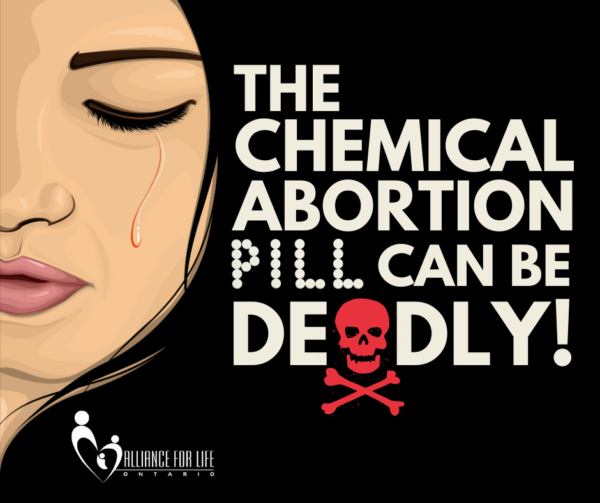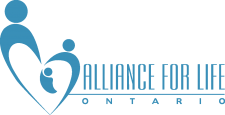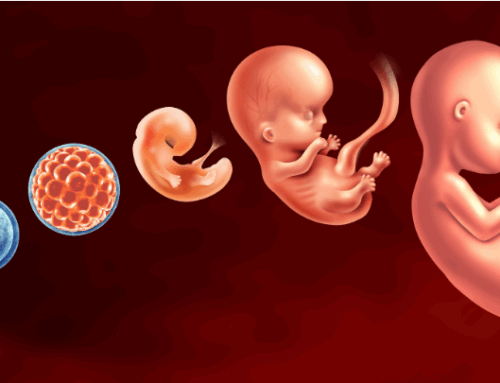 It has occurred to me how important the words we use really are and how, when we change the meaning or the use, they are deceptive and mask the truth. In a recent article authored by Sharon Kirkey which ran in the National Post it was noted that almost 40% of abortions in Canada are “medical” abortions https://nationalpost.com/news/
It has occurred to me how important the words we use really are and how, when we change the meaning or the use, they are deceptive and mask the truth. In a recent article authored by Sharon Kirkey which ran in the National Post it was noted that almost 40% of abortions in Canada are “medical” abortions https://nationalpost.com/news/
“ Mifegymiso is a prescription drug with serious potential risks requiring physician oversight. The need for medical supervision is based on strong evidence for good health and safety outcomes. For example, it is estimated that up to 1 in 20 women who use this drug will require a follow-up surgical procedure because their pregnancy is not successfully terminated. Health Canada has put in place requirements that will help ensure that women have access to medical services in case of a serious adverse event taking place.”
I also believe that it is important to note that pregnancy is a natural outcome after sexual intercourse, not an illness or disease and the overwhelming majority of women who undergo medical abortion are fit and healthy. Pregnancy is another word that is being misused in the discussion around medical abortion. In the Kirkey article we read “Mifepristone blocks the hormone progesterone, which normally helps prepare the lining of the uterus for a pregnancy….Misoprostol causes the uterus to contract, expelling the pregnancy”
Well, I went on the internet and asked what is pregnancy, and good old Wikipedia set me straight.
“This article is about pregnancy in humans………Pregnancy is the time during which one or more offspring develops (gestates) inside a woman’suterus (womb).[4][13] A multiple pregnancy involves more than one offspring, such as twins..”
So, the correct phrasing in the article should have been, “prepare the lining of the womb for pregnancy” and “expelling the offspring” – much clearer I believe. The product monograph for Mifegymiso is more honest.
Mifegymiso Product Monograph
ACTION AND CLINICAL PHARMACOLOGY
Mechanism of Action
When mifepristone blocks progesterone receptors, the endometrium can no longer sustain the growing embryo. Without the effect of progesterone, the lining of the uterus breaks down, and bleeding begins. Mifepristone also triggers an increase in prostaglandin levels and dilates the cervix, facilitating abortion. Misoprostol then induces contractions of the smooth muscle fibers in the myometrium, relaxation of the uterine cervix and evacuation of intrauterine content.
Within two years of licensing Mifegymiso, every safeguard put in place by Health Canada was removed by the Ministry after outcry from abortion activists. Currently women have the dubious freedom to “manage” their own medical abortion!! Leaves me wondering how long it will be before women can manage our own health care completely?
In the UK women have been told; “You will pass the pregnancy at home or another place of your choosing. You can decide how you wish to dispose of the pregnancy remains. They can be flushed down the lavatory or wrapped in tissue, placed in a small plastic bag and put in the dustbin.” https://www.bpas.org/abortion-
So, in plain English, women can decide how to dispose of the body of their tiny child, down the toilet or in the trash. The Kirkey article notes that the UN has listed Mifepristone as an “essential medicine”, So I looked up what that meant.
“Essential medicines are those that satisfy the priority health care needs of the population. They can save lives, reduce suffering and improve health. They are selected based on disease prevalence and public health relevance, evidence of clinical efficacy and safety, and comparative costs and cost-effectiveness. The increasing need for essential medicines due to the growing burden of diseases is stretching country pharmaceutical systems and budgets. Thus, more resources are required for reliable and timely delivery of quality assured medicines as well as their appropriate utilization.”https://www.who.int/
Are we to understand that pregnancy is now defined as a “disease prevalence” or a “growing burden of disease”? Mifegymiso is currently designated as “essential” in part to “reduce suffering” when it has obviously caused suffering to many pregnant women who have used it? How is it life-saving medicine when its direct mechanism of action is to kill the growing human embryo and last year on July 4th in Canada a teenager died from septic shock with Mifegymiso listed under “suspect” in the adverse event report? The Kirkey article also includes a point regarding the supposed safety required in order to be designated an “essential medicine,” yet the Mifegymiso Product Monograph only mentions three clinical trials or “open-label multi-centre studies” including just 1,596 women in the safety analysis. You have to ask why, when one of the largest studies ever to compare surgical and medical abortion was omitted, even though it was completed and published at the time Mifegymiso was licensed in Canada and included a total of 42,619 women, 22,368 of whom underwent medical abortion. Why was this comprehensive study on medical abortion safety not cited? The Finnish study, quoted below, stated that, “The overall incidence of adverse events was fourfold higher in the medical compared with surgical abortion…”. I have not seen this statistic in any official Canadian information on medical abortion. To be clear we are speaking of, 4 times the rates of hemorrhage ,infection, incomplete abortion, surgical re-evacuation.
Finnish Study published 2009
OBJECTIVE:
“To estimate the immediate adverse events and safety of medical compared with surgical abortion using high-quality registry data.
METHODS:
All women in Finland undergoing induced abortion from 2000–2006 with a gestational duration of 63 days or less (n=42,619) were followed up until 42 days postabortion using national health registries. The incidence and risk factors of adverse events after medical (n=22,368) and surgical (n=20,251) abortion were compared. Univariable and multivariable association models were used to analyze the risk of the three main complications (hemorrhage, infection, and incomplete abortion) and surgical (re)evacuation.
RESULTS:
The overall incidence of adverse events was fourfold higher in the medical compared with surgical abortion cohort (20.0% compared with 5.6%, P<.001). Hemorrhage (15.6% compared with 2.1%, P<.001) and incomplete abortion (6.7% compared with 1.6%, P<.001) were more common after medical abortion. The rate of surgical (re)evacuation was 5.9% after medical abortion and 1.8% after surgical abortion (P<.001). Although rare, injuries requiring operative treatment or operative complications occurred more often with surgical termination of pregnancy (0.6% compared with 0.03%, P<.001). No differences were noted in the incidence of infections (1.7% compared with 1.7%, P=.85), thromboembolic disease, psychiatric morbidity, or death.
CONCLUSION:
Both methods of abortion are generally safe, but medical termination is associated with a higher incidence of adverse events. These observations are relevant when counseling women seeking early abortion.”
Ontario Study also shows at least a two times rate of adverse events in women undergoing medical compared to surgical abortion. Published January 2023
https://pubmed.ncbi.nlm.nih.
“Study after study has shown that chemical or “medication” abortion comes with serious risks. Yet abortion pill advocates and, more troublingly, government agencies, continue to assert that the drugs are “safe” and “effective,” arguing for expanded availability and the reduction or elimination of any remaining safeguards.
https://pdf.hres.ca/dpd_pm/00050659.PDF
New Canadian Study
Now, a new study out of Canada makes clear that serious safety issues with these drugs are being ignored. Complications and visits to emergency rooms are much higher than people have been led to believe. These chemical abortions are consistently and measurably more dangerous than their surgical counterparts.
The study, “Short-Term Adverse Outcomes After Mifepristone–Misoprostol Versus Procedural Induced Abortion,” was written by Ning Liu and Joel G. Ray, two researchers from the University of Toronto. The study appeared in the online edition of the Annals of Internal Medicine on January 3, 2023.
Liu and Ray looked at the records of 39,856 women who had chemical or outpatient surgical abortions of 14 weeks gestation or less in Ontario between 2017 and 2020. They were looking for any notation of “adverse events” (complications) occurring within 42 days of the abortion.
The researchers found records of complications with both surgical and chemical abortion, but decidedly more for those undergoing chemical procedures with mifepristone.
All told, there were 1,978 which recorded any adverse event, but the rate for chemical abortions (28.9 per thousand) was more than twice that for the surgical procedures (12.4 per thousand). These adverse events included complications such as hemorrhage, infection, “retained products of conception,” the need for transfusions, and “other.” Except for the infections, which were just barely higher for the surgical group, these complications were all markedly higher for women having chemical abortions…
When considered in terms of emergency room visits, chemical abortions came out even worse. Slightly more surgical patients (4,687) visited their local emergency departments after their abortions than those having chemical ones (4,194). But because there were almost twice as many surgical abortions as there were chemical abortions, rates were much higher for those having abortions with mifepristone and misoprostol.
In all, researchers say, nearly 10.3% of chemical abortion patients visited their ER with some concern or complaint.”
National Right to Life Committee article published in Pregnancy help news https://pregnancyhelpnews.com/
Again, I would note that this study has been available but for some reason not mentioned in the Kirkey article! There was reference to “cherry picking” studies in the article , but pointedly toward the pro-life physicians who brought the case against the FDA regarding Mifepristone licensing and the perceived lack of research. Seems to me that the glass house that is lived in by abortion advocates, medical or otherwise has two gaping holes, I am still left wondering why women cannot be trusted with the truth, if they are going to consider medical abortion surely their decision should be an educated one? It grieves me that those who supposedly stand for choice do not appear to be concerned that women make informed decisions. On a last note, and speaking of informed choice, over 4,000 babies have been saved by abortion pill reversal, but neither our Canadian medical establishment nor the pro-abortion lobby want that little nugget coming out. Women do change their minds and they have a right to a second chance at choice.
https://www.who.int/





